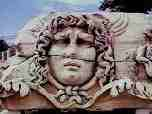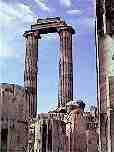Didyma (nearby Didim, in the Aegean region of western Turkey) was a cult center for the city of Miletus. It is located in the present day village of Yeniköy, about 15 kilometers (10 miles) from the site of Miletus. In ancient times, these two cities were connected to each other by a sacred road that had statues located on either side of it.
 The Didymaion, the temple of Apollo and its oracle at Didyma, had a considerable reputation in the ancient times. German archaeologists excavating at the site have shown that the earliest sanctuary here was built in the 8th century BC and that it was enlarged into an enormous temple around 560 BC. After their bloody suppression of the Ionian rebellion, the Persians sacked and laid waste to Miletus (which they regarded as the instigator) and the Didymaion in 494 BC. It was during this assault that the temple's cult statue of Apollo was carried off to Ecbatana (modern Hamadan town in Iran). After Alexander the Great defeated the Persians in 334 BC, the Ionian cities regained their independence and work was begun on reconstructing the temple of Apollo.
The Didymaion, the temple of Apollo and its oracle at Didyma, had a considerable reputation in the ancient times. German archaeologists excavating at the site have shown that the earliest sanctuary here was built in the 8th century BC and that it was enlarged into an enormous temple around 560 BC. After their bloody suppression of the Ionian rebellion, the Persians sacked and laid waste to Miletus (which they regarded as the instigator) and the Didymaion in 494 BC. It was during this assault that the temple's cult statue of Apollo was carried off to Ecbatana (modern Hamadan town in Iran). After Alexander the Great defeated the Persians in 334 BC, the Ionian cities regained their independence and work was begun on reconstructing the temple of Apollo.
Around 300 BC, King Seleukos I of Syria, who then controlled western Anatolia, had the bronze statue of Apollo brought back from Ecbatana to be installed in the new temple, to whose construction he also provided monetary assistance. The new building was designed by the architects Paionios and Daphnis. The former architect was from Ephesus and was one of those who worked on the Artemision there. The temple was planned on a much grander scale than the original sanctuary and indeed it was the third largest religious structure in the ancient world being surpassed only by the Ephesian Artemision and the temple of Hera on the island of Samos. The Hellenistic temple measured 109.34 by 51.13 meters (358 x 167 feet) and had a total of 124 columns. It was set on a seven-stepped platform measuring 3.5 meters (11.5 feet) high and in the center of the east front there was a separate flight of fourteen steps. The construction of this huge building naturally took a long time and continued during the 3rd and 2nd centuries BC. One section was only completed in Roman times. While the temple suffered repeatedly from fires and earthquakes, it sustained the worst damage in an earthquake in 1493.
 The columns still standing measure 2.40 meters (8 feet) in diameter and 19.70 meters (65 feet) in height. The double row of columns surrounding the temple was covered over with a marble roof as was the temple proper. The central courtyard measured 53.63 by 21.71 meters (177 x 72 feet) and was the site of the Archaic period temple. During Hellenistic times, a small temple (called as naiskos) was built here to house the bronze statue of Apollo. Its surrounding walls were 25 meters (82 feet) in height and decorated with Gryphons. The cella was unroofed. East of the adyton (sacred courtyard) is a great stairway of 24 steps measuring 15.20 meters (50 feet) wide. This flight of steps leads up to a windowless, three door hall where the oracle was written down and delivered. The hall measured 20 meters (66 feet) high and had a marble roof. East of the chamber, a door 5.63 meters (18 feet) wide and 14 meters (46 feet) high leads to the pronaos. The pronouncement of the oracles could only be listened to from outside the chamber and there were stairways which led to the upper floor. On either side of the entrance there are doors measuring 2.25 meters high and 1.2 meters wide (7 x 4 feet), and each connects to a narrow, vaulted tunnel leading to the adyton. At the far end of each corridor there is a small propylon-like room.
The columns still standing measure 2.40 meters (8 feet) in diameter and 19.70 meters (65 feet) in height. The double row of columns surrounding the temple was covered over with a marble roof as was the temple proper. The central courtyard measured 53.63 by 21.71 meters (177 x 72 feet) and was the site of the Archaic period temple. During Hellenistic times, a small temple (called as naiskos) was built here to house the bronze statue of Apollo. Its surrounding walls were 25 meters (82 feet) in height and decorated with Gryphons. The cella was unroofed. East of the adyton (sacred courtyard) is a great stairway of 24 steps measuring 15.20 meters (50 feet) wide. This flight of steps leads up to a windowless, three door hall where the oracle was written down and delivered. The hall measured 20 meters (66 feet) high and had a marble roof. East of the chamber, a door 5.63 meters (18 feet) wide and 14 meters (46 feet) high leads to the pronaos. The pronouncement of the oracles could only be listened to from outside the chamber and there were stairways which led to the upper floor. On either side of the entrance there are doors measuring 2.25 meters high and 1.2 meters wide (7 x 4 feet), and each connects to a narrow, vaulted tunnel leading to the adyton. At the far end of each corridor there is a small propylon-like room.
Today, the towns of Didim, Altinkum and Akbük are popular holiday resorts with their sandy beaches. Lately, many foreigners have bought (and continue to buy) property in and around Didim for their holidays or for the retirement. It became a popular area especially for the British nationals.

